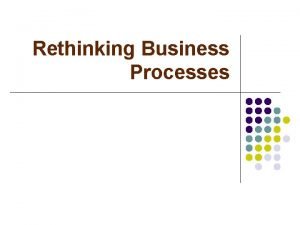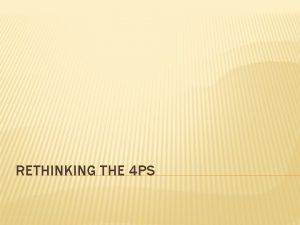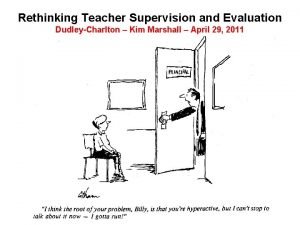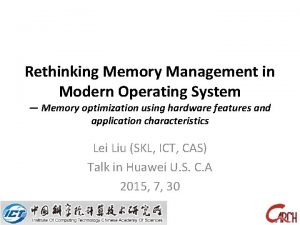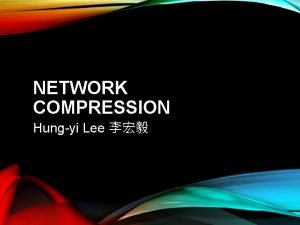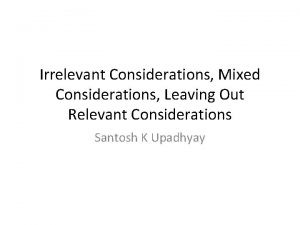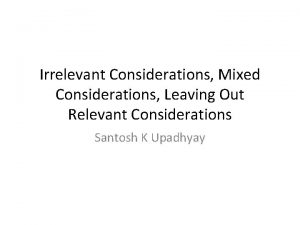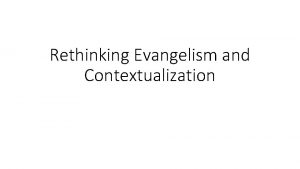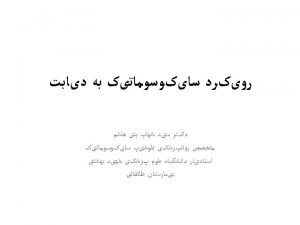Rethinking i Education Considerations from Research in the














- Slides: 14

Re-thinking i. Education: Considerations from Research in the Learning Sciences Gerry Stahl

Opportunities A faculty retreat on innovation n Brainstorm — suspend reactions n Technologies to support new modes of learning n Research on how people learn n

Dangers Technology-driven thinking n The inertia of culture: “That’s how we have always done it. ” n Disincentives in the reward structures: for students, instructors, the College n

A pop quiz As we learn more about something, n (a) The questions all get answered. n (b) The questions get easier and easier. n (c) The questions get more complex. n n How can we promote deep inquiry by students?

Learning sciences research Cambridge Handbook on the Learning Sciences n International Journal of Computer. Supported Collaborative Learning n Research papers at CSCL, ICLS, CHI, CSCW, GROUP, etc. n

Findings of learning sci & ed tech Students must be engaged, motivated; construct their own understanding n Lectures are not generally effective as the sole instructional mode n Asynchronous threaded discussion has serious problems (timing, superficial opinions, asocial) n

Some of my research: asynch n n n Phidias - threaded discussion for design rationale (1990 -1992 RA in computer science) Hermes - asynchronous design environment (1991 -1993 dissertation system) Other educational software: Essence, TCA (1993 -1997) Web. Guide (1997 -2000 post-doc classroom system) BSCL (2001 -2002 visiting scientist EU asynch) VMT (2003 -2009 synchronous learning)

My theory of group cognition Vygotsky: inter-personal learning precedes as the basis of individual learning n Small groups have powerful learning mechanisms n Technology should be designed to support intense group interaction n Pedagogy should support collaborative knowledge building n

Collaboration is powerful! Breaks passivity & asocial alienation n Students work together to understand assignments, course goals, material n Students help each other n Students make their knowledge visible n Students can judge themselves vs. peers n 80% of employees work in teams n

Synchronicity Synchronous (e. g. , chat) is more engaging n It has a stronger sense of social contact n It is far more efficient in building knowledge n It can support interaction & collaboration n It allows immediate feedback, deeper discussion, sharing, negotiation n

Blending it Blended learning combines the advantages and overcomes many problems n Almost all online programs (outside Drexel) find that F 2 F contact near the beginning is necessary for meaningful asynch interaction n

Conclusion A careful mix of individual, small-group and class work n A careful mix of reading, lecture, smallgroup tasks, class discussion n Use of technology as appropriate to pedagogical aims and processes n

An i. School culture of innovation & collaborative learning How can we change student resistance to innovation in instruction & learning? n How can we change student resistance to sharing knowledge & group work? n How can we blend our online courses? n How can we introduce synchronicity? n

References on the power of collaboration n Stahl, G. (2008). Chat on collaborative knowledge building. QWERTY, 3(1), 67 -78. n Computersupported collaborative learning. In R. K. Sawyer Stahl, G. , Koschmann, T. , & Suthers, D. (2006). (Ed. ), Cambridge handbook of the learning sciences (pp. 409 -426). Cambridge, UK: Cambridge University Press. Available in English, in simplified Chinese, in traditional Chinese, in Spanish, in Portuguese, in German, in Romanian.
 Rethinking engineering education: the cdio approach
Rethinking engineering education: the cdio approach Rethinking education: towards a global common good?
Rethinking education: towards a global common good? Ethical issues of experimental research
Ethical issues of experimental research Ethical consideration
Ethical consideration Dissect the broad area into sub areas example
Dissect the broad area into sub areas example Intro lll
Intro lll Rethinking the 4 p's
Rethinking the 4 p's Rethinking expertise
Rethinking expertise Rethinking teacher supervision and evaluation
Rethinking teacher supervision and evaluation Rethinking file mapping for persistent memory
Rethinking file mapping for persistent memory Rethinking the value of network pruning
Rethinking the value of network pruning Rethinking file mapping for persistent memory
Rethinking file mapping for persistent memory What is the fundamental rethinking of business processes
What is the fundamental rethinking of business processes What are the general considerations in machine design
What are the general considerations in machine design Tax considerations for setting up a new business
Tax considerations for setting up a new business





